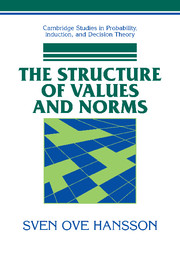Book contents
- Frontmatter
- Contents
- Preface
- PROLEGOMENA
- PART I VALUES
- 2 Exclusionary Preferences
- 3 Preference States
- 4 Changes in Exclusionary Preferences
- 5 Constructing Combinative Preferences
- 6 Pairwise Combinative Preferences
- 7 Decision-Guiding Combinative Preferences
- 8 Monadic Value Predicates
- PART II NORMS
- EPILOGUE
- Proofs
- References
- Index of Symbols
- General Index
2 - Exclusionary Preferences
Published online by Cambridge University Press: 13 August 2009
- Frontmatter
- Contents
- Preface
- PROLEGOMENA
- PART I VALUES
- 2 Exclusionary Preferences
- 3 Preference States
- 4 Changes in Exclusionary Preferences
- 5 Constructing Combinative Preferences
- 6 Pairwise Combinative Preferences
- 7 Decision-Guiding Combinative Preferences
- 8 Monadic Value Predicates
- PART II NORMS
- EPILOGUE
- Proofs
- References
- Index of Symbols
- General Index
Summary
From a logical point of view, the major value concepts of ordinary language can be divided into two categories. The monadic (classificatory) value concepts, such as ‘good,’ ‘very bad,’ and ‘worst,’ evaluate a single referent. The dyadic (comparative) value concepts, such as ‘better,’ ‘worse,’ and ‘equal in value to,’ indicate a relation between two referents. Chapters 2–7 are devoted to the dyadic concepts and Chapter 8 to the monadic ones.
In Chapters 2–4, the objects of preferences are assumed to be mutually exclusive, that is, none of them is compatible with, or included in, any of the others. No further assumptions are made about their internal structure. They may be physical objects, types or properties of such objects, states of affairs, possible worlds – just about anything. Preferences over a set of mutually exclusive relata will be referred to as exclusionary. The condition of mutual exclusivity is removed in Chapters 5–7.
SOME BASIC CONDITIONS
The values held and endorsed by an individual are complex and intricately connected with that individual's beliefs and emotions. The very process of isolating her values from the rest of her mind involves a considerable idealization, and the further process of expressing these isolated values in terms of a binary relation takes idealization one step further. It can hardly be a reasonable criterion of rationality that these two steps can be taken in only one way, which involves no distortion of the original.
- Type
- Chapter
- Information
- The Structure of Values and Norms , pp. 15 - 32Publisher: Cambridge University PressPrint publication year: 2001



